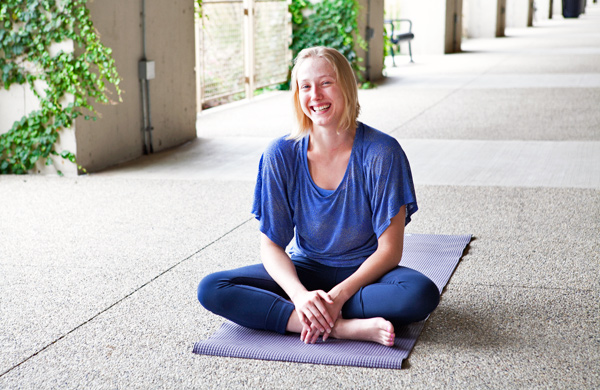
CorePower Yoga instructor Anna Counts wasn’t drawn to yoga for its meditative benefits. She wasn’t seeking pain relief or increased flexibility. Anna began practicing yoga because she needed to save her body.
“I actually started doing yoga while I was in a treatment program for anorexia,” Anna explains. “I didn’t do anything for six months. I was just supposed to sit around and gain weight. And then I wanted to start moving.” But she wasn’t ready to return to her former haunt—the ballet studio—so Anna turned to yoga.
“Yoga’s all about changing your body, and it’s sort of phenomenal to start with a skeleton...I literally built my body up from scratch. And it was excellent for body image because you start to see your body as a functional object as opposed to an aesthetic object. It helped me change my mindset a lot.”
Today, seven years after she began practicing as a student, Anna teaches yoga full-time at CorePower studios around Chicago. But she still deals with acid reflux—a lingering reminder of her struggles with food. Luckily, it’s something that, like other post-meal discomforts, can be relieved with a few simple yoga moves. Here, Anna demonstrates how a sequence of seven postures can calm an unsettled digestive system.
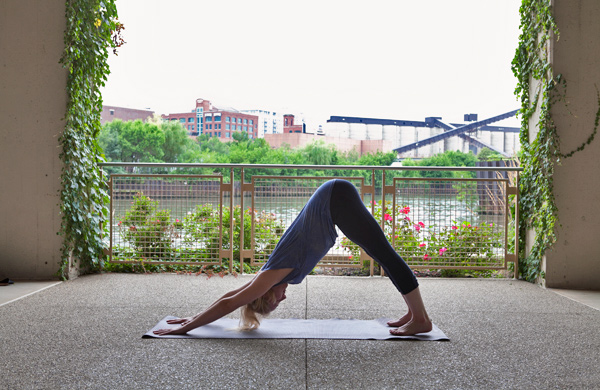 1. Downward-Facing Dog
1. Downward-Facing Dog
The quintessential yoga move, this pose works to compress “everything going on in the abdominals,” as Anna puts it, which can calm any disrest. To perform it, plant your feet and hands on the ground at about hip distance apart, then push back, raising your tailbone into the air. Hold for a few moments.
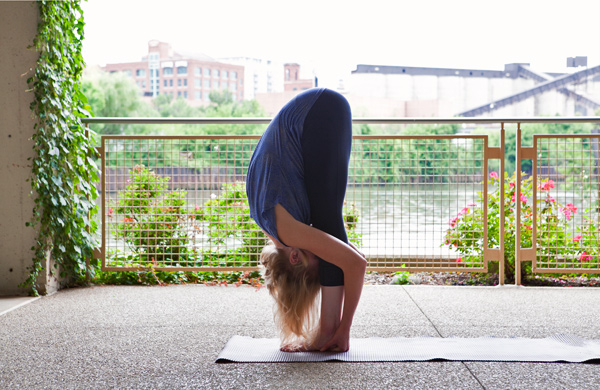 2. Padahastasana
2. Padahastasana
More commonly known as “forward fold,” this position boosts the effect of a downward-facing dog by intensifying the fold. Stand up with straight with your feet planted, and then hinge at the hips, dropping forward until your fingers can touch the ground. Simply hang in this position for a few moments.
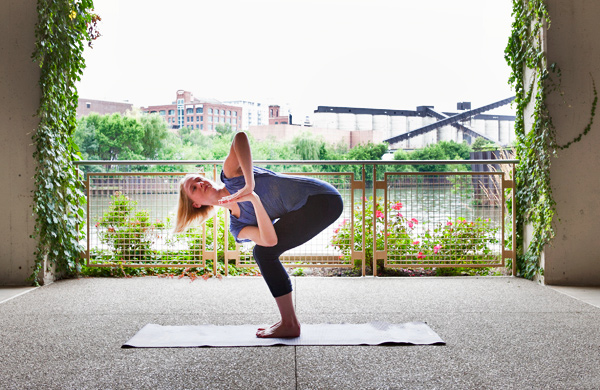 3. Chair Twist
3. Chair Twist
Bend your knees and sink your hips back, placing your hands together in a prayer position. Twist your torso to the right, pulling your hands with you until they reach the outside of your right hip. Hold, and then rotate everything back to center. Repeat this sequence on the left side. “When you’re twisting, you’re working with your ascending and your descending colon,” Anna says. Twisting to the right first opens the ascending colon, and twisting to the left then opens the descending colon, which ensures that their contents keep moving smoothly. For a deeper stretch, reach one hand toward the sky and one hand toward the ground upon reaching the hip.
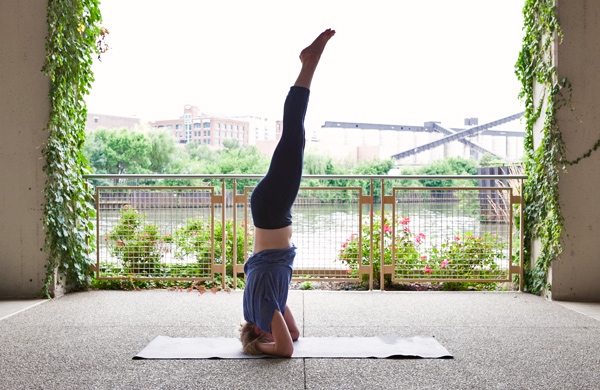 4. Salamba Sirsasana
4. Salamba Sirsasana
An inversion changes the way gravity affects your digestive tract. Though it’s not recommended for acid reflux, a supported headstand can help ease other digestive issues. For a seasoned yogi: position your elbows beneath your shoulders, clasp your hands behind your head, and then lift your legs straight to the sky. For a beginner: modify this by performing the headstand against a wall. Or, opt for a shoulder stand instead: lie flat on your back and raise your hips over your head, supporting the lower back with your hands and lifting your toes skyward.
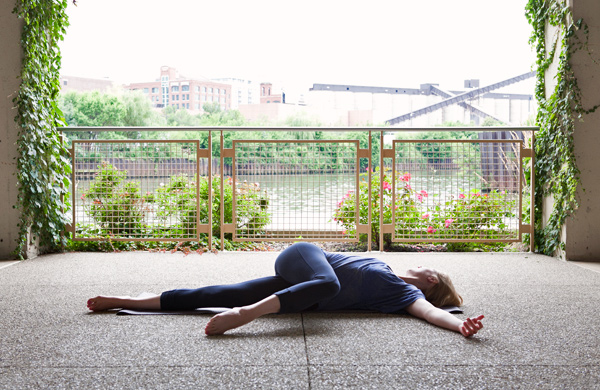 5. Supine Twist
5. Supine Twist
Like the chair twist, the supine twist also stretches the digestive tract from right to left—the direction in which food moves through it. Lie flat on your back and, with your right knee bent at about 90 degrees, shift your right leg over your left (which stays long). Then reach your left hand long across your body, twisting your head to look toward your left palm. Repeat this on the other side.
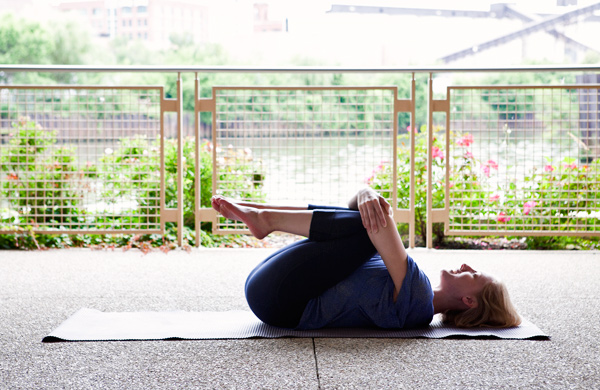 6. Wind-Relieving Pose
6. Wind-Relieving Pose
The wind-relieving pose is as straightforward as its name. Lie on your back and clasp your knees to your chest, wrapping your arms around them.
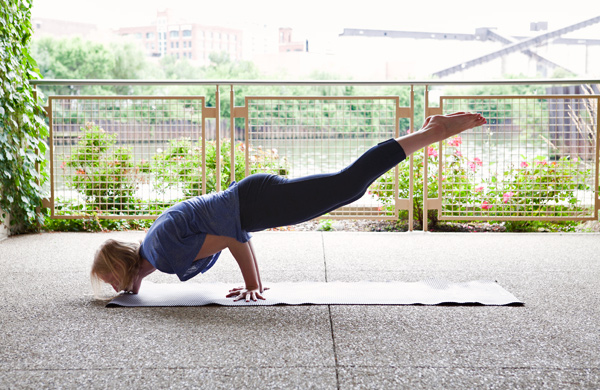 7. Peacock
7. Peacock
Anna notes that this challenging arm balance is not for the novice yogi. Start by planting your palms flat on the ground with wrists close together and stretching your fingers back toward your feet or away from each other. Lean forward, digging your elbows into your stomach and lifting your legs (keeping them straight and in line with your spine). Placing your lips on the floor can help aid balance. According to Anna, it’s the pressure from your elbows which helps assuage upset tummies.
Photo: © Michelle Klosinski, Groupon





 CorePower Yoga instructor Anna Counts wasn’t drawn to yoga for its meditative benefits. She wasn’t seeking pain relief or increased flexibility. Anna began practicing yoga because she needed to save her body.
“I actually started doing yoga while I was in a treatment program for anorexia,” Anna explains. “I didn’t do anything for six months. I was just supposed to sit around and gain weight. And then I wanted to start moving.” But she wasn’t ready to return to her former haunt—the ballet studio—so Anna turned to yoga.
“Yoga’s all about changing your body, and it’s sort of phenomenal to start with a skeleton...I literally built my body up from scratch. And it was excellent for body image because you start to see your body as a functional object as opposed to an aesthetic object. It helped me change my mindset a lot.”
Today, seven years after she began practicing as a student, Anna teaches yoga full-time at CorePower studios around Chicago. But she still deals with acid reflux—a lingering reminder of her struggles with food. Luckily, it’s something that, like other post-meal discomforts, can be relieved with a few simple yoga moves. Here, Anna demonstrates how a sequence of seven postures can calm an unsettled digestive system.
CorePower Yoga instructor Anna Counts wasn’t drawn to yoga for its meditative benefits. She wasn’t seeking pain relief or increased flexibility. Anna began practicing yoga because she needed to save her body.
“I actually started doing yoga while I was in a treatment program for anorexia,” Anna explains. “I didn’t do anything for six months. I was just supposed to sit around and gain weight. And then I wanted to start moving.” But she wasn’t ready to return to her former haunt—the ballet studio—so Anna turned to yoga.
“Yoga’s all about changing your body, and it’s sort of phenomenal to start with a skeleton...I literally built my body up from scratch. And it was excellent for body image because you start to see your body as a functional object as opposed to an aesthetic object. It helped me change my mindset a lot.”
Today, seven years after she began practicing as a student, Anna teaches yoga full-time at CorePower studios around Chicago. But she still deals with acid reflux—a lingering reminder of her struggles with food. Luckily, it’s something that, like other post-meal discomforts, can be relieved with a few simple yoga moves. Here, Anna demonstrates how a sequence of seven postures can calm an unsettled digestive system.
 1. Downward-Facing Dog
The quintessential yoga move, this pose works to compress “everything going on in the abdominals,” as Anna puts it, which can calm any disrest. To perform it, plant your feet and hands on the ground at about hip distance apart, then push back, raising your tailbone into the air. Hold for a few moments.
1. Downward-Facing Dog
The quintessential yoga move, this pose works to compress “everything going on in the abdominals,” as Anna puts it, which can calm any disrest. To perform it, plant your feet and hands on the ground at about hip distance apart, then push back, raising your tailbone into the air. Hold for a few moments.
 2. Padahastasana
More commonly known as “forward fold,” this position boosts the effect of a downward-facing dog by intensifying the fold. Stand up with straight with your feet planted, and then hinge at the hips, dropping forward until your fingers can touch the ground. Simply hang in this position for a few moments.
2. Padahastasana
More commonly known as “forward fold,” this position boosts the effect of a downward-facing dog by intensifying the fold. Stand up with straight with your feet planted, and then hinge at the hips, dropping forward until your fingers can touch the ground. Simply hang in this position for a few moments.
 3. Chair Twist
Bend your knees and sink your hips back, placing your hands together in a prayer position. Twist your torso to the right, pulling your hands with you until they reach the outside of your right hip. Hold, and then rotate everything back to center. Repeat this sequence on the left side. “When you’re twisting, you’re working with your ascending and your descending colon,” Anna says. Twisting to the right first opens the ascending colon, and twisting to the left then opens the descending colon, which ensures that their contents keep moving smoothly. For a deeper stretch, reach one hand toward the sky and one hand toward the ground upon reaching the hip.
3. Chair Twist
Bend your knees and sink your hips back, placing your hands together in a prayer position. Twist your torso to the right, pulling your hands with you until they reach the outside of your right hip. Hold, and then rotate everything back to center. Repeat this sequence on the left side. “When you’re twisting, you’re working with your ascending and your descending colon,” Anna says. Twisting to the right first opens the ascending colon, and twisting to the left then opens the descending colon, which ensures that their contents keep moving smoothly. For a deeper stretch, reach one hand toward the sky and one hand toward the ground upon reaching the hip.
 4. Salamba Sirsasana
An inversion changes the way gravity affects your digestive tract. Though it’s not recommended for acid reflux, a supported headstand can help ease other digestive issues. For a seasoned yogi: position your elbows beneath your shoulders, clasp your hands behind your head, and then lift your legs straight to the sky. For a beginner: modify this by performing the headstand against a wall. Or, opt for a shoulder stand instead: lie flat on your back and raise your hips over your head, supporting the lower back with your hands and lifting your toes skyward.
4. Salamba Sirsasana
An inversion changes the way gravity affects your digestive tract. Though it’s not recommended for acid reflux, a supported headstand can help ease other digestive issues. For a seasoned yogi: position your elbows beneath your shoulders, clasp your hands behind your head, and then lift your legs straight to the sky. For a beginner: modify this by performing the headstand against a wall. Or, opt for a shoulder stand instead: lie flat on your back and raise your hips over your head, supporting the lower back with your hands and lifting your toes skyward.
 5. Supine Twist
Like the chair twist, the supine twist also stretches the digestive tract from right to left—the direction in which food moves through it. Lie flat on your back and, with your right knee bent at about 90 degrees, shift your right leg over your left (which stays long). Then reach your left hand long across your body, twisting your head to look toward your left palm. Repeat this on the other side.
5. Supine Twist
Like the chair twist, the supine twist also stretches the digestive tract from right to left—the direction in which food moves through it. Lie flat on your back and, with your right knee bent at about 90 degrees, shift your right leg over your left (which stays long). Then reach your left hand long across your body, twisting your head to look toward your left palm. Repeat this on the other side.
 6. Wind-Relieving Pose
The wind-relieving pose is as straightforward as its name. Lie on your back and clasp your knees to your chest, wrapping your arms around them.
6. Wind-Relieving Pose
The wind-relieving pose is as straightforward as its name. Lie on your back and clasp your knees to your chest, wrapping your arms around them.
 7. Peacock
Anna notes that this challenging arm balance is not for the novice yogi. Start by planting your palms flat on the ground with wrists close together and stretching your fingers back toward your feet or away from each other. Lean forward, digging your elbows into your stomach and lifting your legs (keeping them straight and in line with your spine). Placing your lips on the floor can help aid balance. According to Anna, it’s the pressure from your elbows which helps assuage upset tummies.
Photo: © Michelle Klosinski, Groupon
7. Peacock
Anna notes that this challenging arm balance is not for the novice yogi. Start by planting your palms flat on the ground with wrists close together and stretching your fingers back toward your feet or away from each other. Lean forward, digging your elbows into your stomach and lifting your legs (keeping them straight and in line with your spine). Placing your lips on the floor can help aid balance. According to Anna, it’s the pressure from your elbows which helps assuage upset tummies.
Photo: © Michelle Klosinski, Groupon
